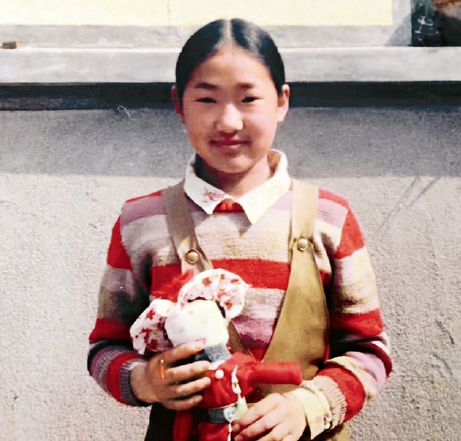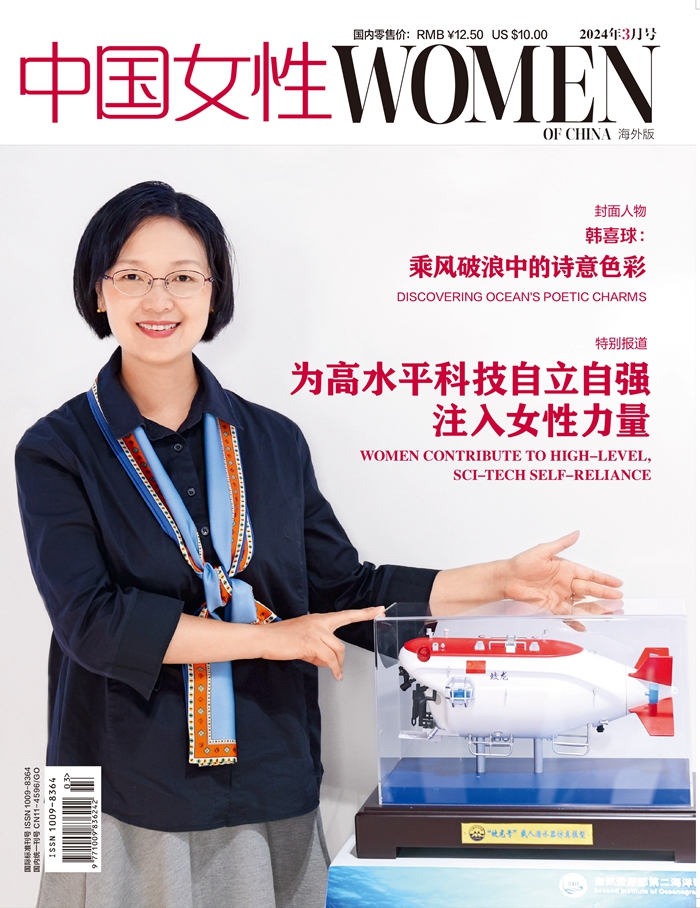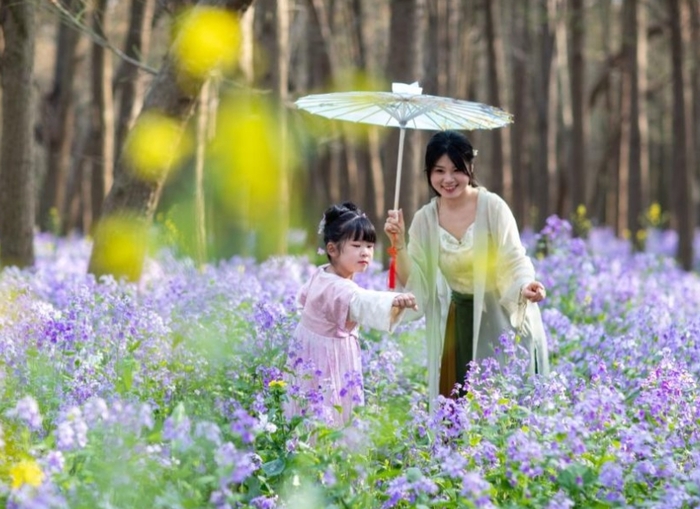Passing Embroidering Skills Through Generations
 |
| Bian Chengfei (second from right) making hand-sewn embroideries with her mother and daughter in April 2023 |
Bian Chengfei is an inheritor of hand-sewn embroidering, a provincial-level intangible cultural heritage, in East China's Shandong Province. Bian has received many awards and titles, because of her efforts to inherit and protect hand-sewn-embroidering skills, to develop rural tourism, and to lead people in escaping poverty by increasing their incomes through making hand-sewn embroideries.
 |
| Bian Chengfei, with the first doll she ever made. The photo was taken in the autumn of 1995. |
My name is Bian Chengfei. I was born into a family of hand-sewn embroiderers in Feixian, a county in East China's Shandong Province, in 1984. Feixian is located in the Yimeng Mountains, a revolutionary base in Shandong.
Being diligent and thrifty are among my family's traditions. When I was young, my grandmother was responsible for breeding silkworms, dyeing silk threads and embroidering insoles. My father was responsible for spinning thread and weaving cloth. My mother was responsible for making shoes and hats. They often worked hard — until late.
My siblings and I were greatly influenced by our parents. We were all interested in arts and crafts. My elder brother liked making woodwork. My younger brother liked calligraphy and painting. My elder sister liked making cotton cloth. I liked doing needlework.
I made a cloth doll, and doll's clothes, when I was in the third grade of primary school. Even though it was not overly exquisite, my family was excited by my "success." My parents even invited a photographer to take a photo of me. At that time, taking a photo was a grand affair for rural children in China. The encouragement and expectations of my family lit my dream of eventually working in the hand-sewn-embroidery industry.
In 2000, I was enrolled in Lin Yi Art School, where I studied painting. I hoped to learn and apply art skills to hand-sewn embroideries. I made unremitting efforts to study embroidering skills after I graduated from the art school. I opened a hand-sewn embroidering shop in the village. My embroideries gradually became famous in surrounding villages.
Even though my embroidering skills greatly improved, my parents encouraged me to leave home to learn more embroidering skills. With their support, I visited many craftspeople, near and far. I learned dozens of needle-work methods from them, which helped improve my embroidering. My embroideries were then well received at many cultural exhibitions.
At one exhibition, a folk artist suggested I should add more characteristic elements of my hometown to my embroideries. I was inspired by the suggestion. I decided to highlight the distinctive regional characteristics on my crafts.
I improved some traditional patterns of embroideries, such as the tiger, chrysanthemum and plum flowers. I used red, green, pink and black as the embroideries' main colors, to reflect their "rural" features. I also sought advice from medical personnel about the components and proportions of Chinese medicinal herbs, which are filled in the crafts (such as sachets). When I had time, I would select herbs personally, and I would supervise the process of grinding the herbs. Moreover, I decorated the crafts with silver, glazed and/or other ornaments, to make them more fashionable.
In 2014, I established a crafts company, and I began to lead villagers in making hand-sewn embroideries, and other crafts. Later, I set up a training base, and a poverty-relief workshop, to make hand-sewn embroideries. The base offered training sessions to nearly 24,000 people. The workshop provided job opportunities to more than 1,500 people — including left-behind women, the elderly, the disabled, and the impoverished — in the county.
In recent years, I have received many awards and titles, because of my efforts to inherit and protect hand-sewn-embroidering skills, to develop rural tourism, and to lead people in escaping poverty by increasing their incomes through making hand-sewn embroideries.
In 2021, hand-sewn embroidering was added to the list of items of intangible cultural heritage in Shandong. The next year, I was invited to attend the China Intangible Cultural Heritage Expo, in Jinan, capital of Shandong. I demonstrated how to make hand-sewn embroideries to visitors to the expo. Now, our embroideries are sold overseas, including in Russia, Sweden, Malaysia, and the Republic of Korea.
My daughter is 7 years old. When she was an infant, she played with balls of silk thread and strips of cloth. She began learning how to use a needle at the age of 3. She was able to embroider sachets when she was 4. She has since mastered many hand-sewnembroidering methods. We often draw patterns and make embroideries together after she comes home from school. When the weather is fine, my mother and I make embroideries, with my daughter, in the courtyard. My mother and daughter embroider the outlines of the patterns, and I embroider the details. We all enjoy such a happy life.
I have led local women in shaking off poverty, and I have helped others inherit and develop hand-sewn-embroidering skills. In future, I plan to help develop the industries of hand-sewn embroidering and other folk arts in North China, and I plan to lead villagers in living a better life!
Photos Supplied by Interviewee
(Women of China English Monthly July 2023 issue)
Please understand that womenofchina.cn,a non-profit, information-communication website, cannot reach every writer before using articles and images. For copyright issues, please contact us by emailing: website@womenofchina.cn. The articles published and opinions expressed on this website represent the opinions of writers and are not necessarily shared by womenofchina.cn.








 WeChat
WeChat Weibo
Weibo 京公网安备 11010102004314号
京公网安备 11010102004314号